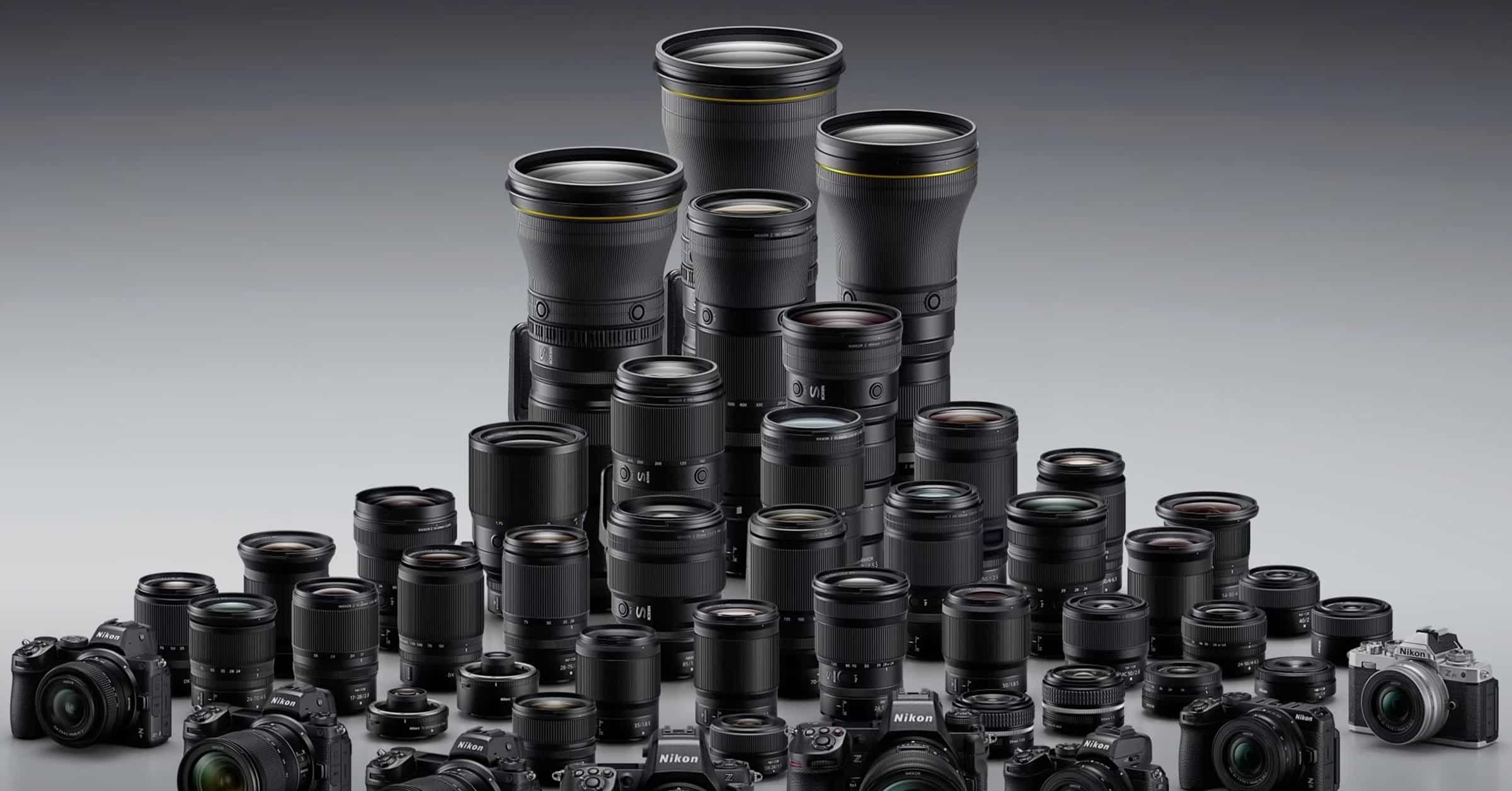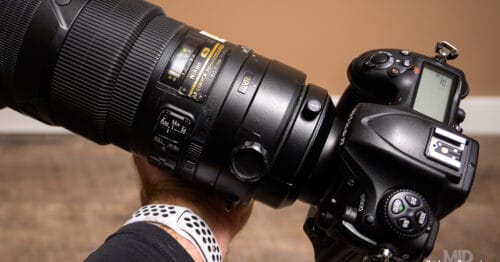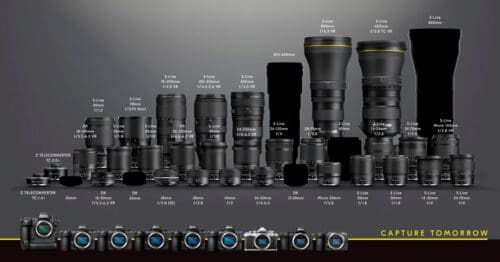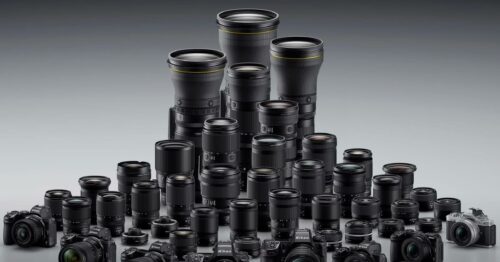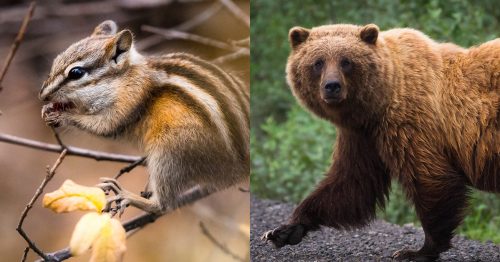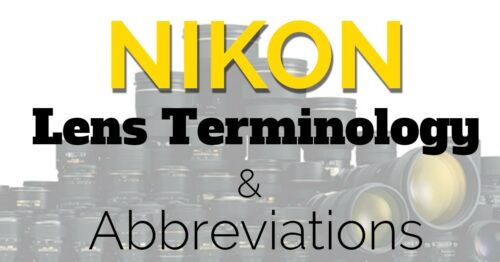The Nikon 600mm f/6.3 VR S is one of the best-performing super-telephoto lenses I have ever tested for any camera brand. It is ludicrously sharp, and the lightweight PF (Phase Fresnel) design puts the fun back into wildlife photography, allowing me to carry it all day and barely break a sweat. Initially, I bought this lens for testing and review, but I quickly decided it was a lifelong keeper. When I know I’ll be hanging onto a lens, I like to get it kitted out with all the best accessories, and I also spend some time finding the best camera bag for it.
In this post, I’ll show you the best camera bag for the Nikon Z 600mm f/6.3 VR S lens and discuss a variety of crucial accessories such as an Arca-compatible lens foot, third-party lightweight lens hoods, replacement lens caps, rain covers, protective covers, and much more. You’ve come to the right place if you’ve just bought the Nikon 600mm f/6.3 and want to kit it out with all the best gear before your next trip.

Why trust me? The internet is full of garbage written by AI and people who pretend to use the photo gear they are testing. On the other hand, I get out there and do the work, as evidenced by the images I create along the way and the stories I share with my followers. If you want to support an independent creator, please consider sharing this article, subscribing to my newsletter, leaving a tip, or purchasing through links on this page.
Don’t have your Nikon 600mm f/6.3 yet? Support my efforts by buying it through one of our links:
- Nikon Z 600mm f/6.3 VR S Lens – Amazon / B&H / Adorama / Lensrentals / WEX (UK) / Camera Canada



Table of Contents
Camera Bags for the Nikon Z 600mm f/6.3 VR S
Getting the right camera bag for your gear can make a day in the field or a day of air travel much more manageable. So, which camera bag is just right for the Nikon Z 600mm f/6.3? I have traveled worldwide with this lens and reviewed over 100 camera bags for this website in the last decade. Many of these bags remain at my office as I’m constantly testing them with new lenses to find the gear/bag combinations that make the most sense to recommend to my readers. We’re going to dig into that data now.
When choosing the best camera bag for the Nikon Z 600mm f/6.3, the main question is: Do you want to keep a camera attached to the lens, or do you want to prioritize (i.e., minimize) the bag size for ease of travel? My answer to this question varies, so I’m including a few options that suit both scenarios. Each recommended camera bag for the Nikon 600mm f/6.3 also has a full-length companion review, linked within the sub-sections below if you want to delve deep.
Gura Gear Kiboko 16L+ and 22L+
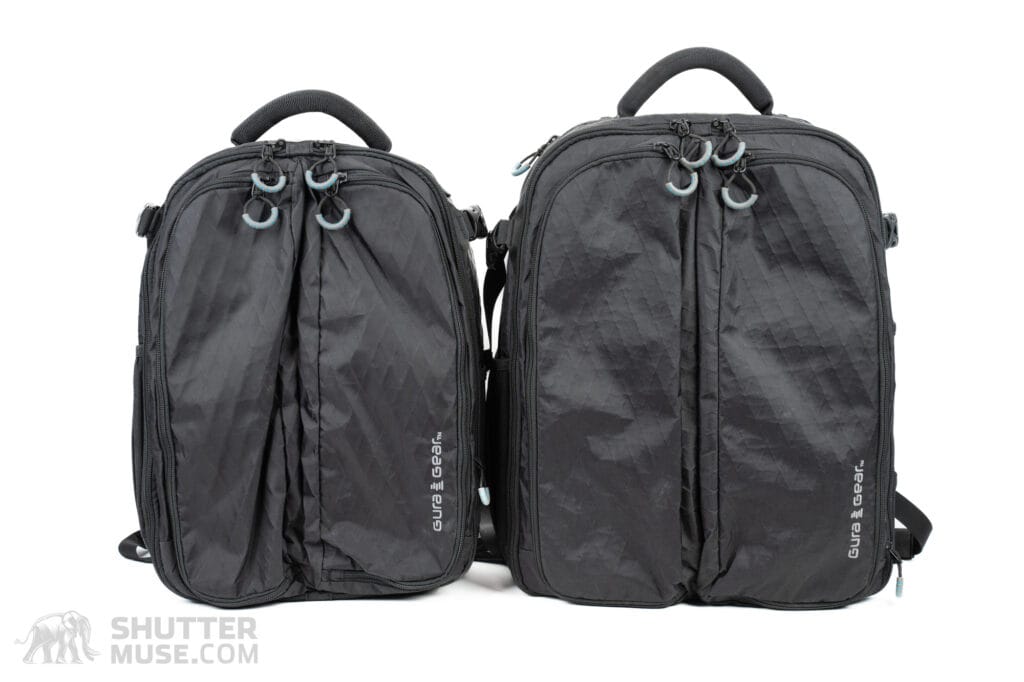
In my travels around the world for wildlife photography, it’s not unusual for me to encounter tour groups where every participant uses a Gura Gear Kiboko V2.0. As far as I can tell from my on-the-ground beta, these Kiboko V2.0 camera bags are the single most popular camera bag for wildlife photographers using super-telephoto lenses.


There are good reasons for this popularity. Firstly, the unique butterfly design allows quick access to a pair of lenses with attached camera bodies. This optimal wildlife photography setup usually entails having a prime super-telephoto prime or a long-range zoom (180-600mm) on one side of the bag, with a shorter telephoto zoom, such as a 100-400mm or 70-200mm, on the other side of the bag.
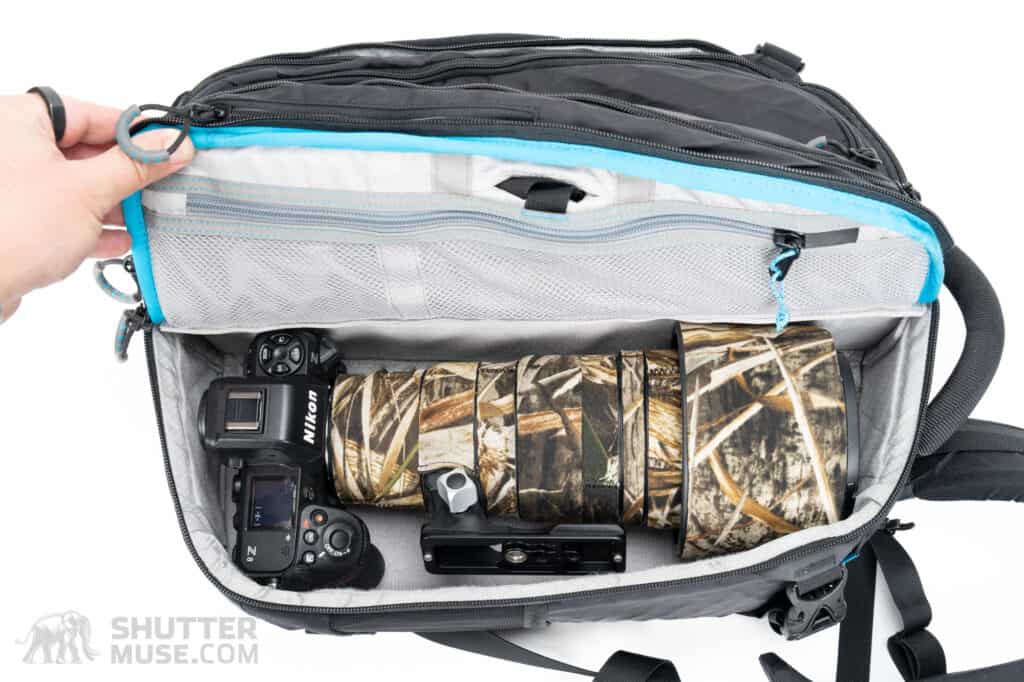
The second reason these bags are so popular is their space-efficient sizing, making them easily compliant with international carry-on regulations. The boxy shape uses every inch available within the baggage regulations and allows you to carry a huge amount of gear for the bag’s size. Thirdly, these bags have near-legendary durability. Built from VX21 X-Pac sailcloth, they can withstand the rigors of air travel and time in the field for many years.

The Kiboko V2.0 is available in three sizes: 16L, 22L and 30L. The 30L version is designed to carry 600mm f/4, 800mm, or 400mm f/2.8 lenses, so we can discount that one for our lightweight 600mm f/6.3 lens. The photos above demonstrate the Nikon Z 600mm f/6.3 VR S in the Gura Gear Kiboko 16L+ and 22L+. As you can see, the Kiboko 16L+ easily accommodates the Z 600mm f/6.3 lens attached to a standard-size mirrorless camera. If you prioritize (smallest) bag size, go for the Kiboko 16L+.
While the lens and camera fit nicely in the 16L+, the better choice for most people is the Kiboko 22L+. The Kiboko 22L+ works with larger camera bodies and has a proper hip belt, lacking in the 16L+. I also find the 22L+ to feel less cramped when I want to carry a companion zoom on the other side of the bag, like the Z 100-400mm, along with a second body and a wide-angle zoom for some landscapes along the journey. The 22L+ is also slightly wider than the 16L+, making it less of a squeeze to fit the fairly chunky Z8 or Z9 bodies.
For more information, check out my in-depth Gura Gear Kiboko review.
Gura Gear has offered Shutter Muse readers a 10% discount on anything purchased in their online store. Just use the discount code SHUTTERMUSE10 after clicking here to access their store.
Think Tank Digital Holster 150

This great shoulder bag carries the Nikon Z 600mm f/6.3 with an attached camera body, and the hood reversed; anything up to a Z9 will fit. There’s a zippered pocket suitable for a spare battery, a couple of memory cards, and a side pocket that will hold the Nikon Z 1.4x teleconverter. The bag has a waterproof rain cover, a padded shoulder strap, and the ability to connect it with one of Think Tank’s photo belts to spread the weight to your hips.
I use this bag with my Z 600mm f/6.3 in a few ways. Firstly, it’s a brilliant way to carry the lens in your car if you need something for those unexpected wildlife appearances on the roadside. In the Yukon where I live, any drive from my house to the nearest town can result in moose, grizzly bear, lynx, or even wolf sightings. I used to carry my big 600mm f/4 alongside me whenever possible, but these days, I opt for the far more manageable-in-a-car Z 600mm f/6.3.
The second way I use the Think Tank Digital Holster 150 is for a grab-and-go wildlife kit while walking my dogs on the local trails behind my house. You never know what will pop out of the bushes, and for my daily 30 to 60-minute dog walks, this bag holds everything I need. Finally, this is a great way to protect this lens with an attached camera body when you want to pack it into a bag not designed to be a camera bag. Say, a duffel bag or a bag intended for another specific purpose, such as skiing.
My review of this Digital Holster 150 camera bag has more details, but suffice it to say, it has Think Tank’s legendary build quality and a moderate price point that shouldn’t worry owners of this lens.
US Customers spending over $50 in Think Tank Photo’s online store can get a free gift at checkout after following one of the links to the store from this review–like this one. If you have any issues, please follow the instructions on this page.
Gura Gear Kiboko City Classic

In my review of the Gura Gear Kiboko City Classic, I called it the best camera bag for most people. In our case, as you can see, the Z 600mm f/6.3 fits in the bag without a camera attached. The Kiboko City Classic features extensive organization, a 16″ laptop sleeve, a tablet sleeve, incredibly durable X-Pac sailcloth materials, and a daily carry 18L sizing. If you want to carry this lens as part of a simple two or 3-lens kit alongside everyday tech items and travel essentials, the Kiboko City Classic is the one for you.

Considering the lens kit in the photo, which shows the 600mm and the Z 24-120mm f/4, along with both Nikon Z teleconverters, also consider that there is plenty of room for either the Z 70-200mm f/2.8 or Z 100-400mm in the top part of the bag. This would effectively have you covered from 24-1200mm in a 3-lens kit, all in a bag that is small enough to qualify as a personal item on some airlines. Is this the ultimate ultralight travel kit? It may just be. Check the Kiboko City Classic review for many more images.
Gura Gear has offered Shutter Muse readers a 10% discount on anything purchased in their online store. Just use the discount code SHUTTERMUSE10 after clicking here to access their store.
Think Tank BackLight Sprint

Think Tank Photo’s popular BackLight series comes in four different sizes, but it’s the smallest Sprint model that I’m choosing to include in this list. The reason for picking this model is that it aligns closely with the concept of the incredibly lightweight Z 600mm f/6.3 lens. If you have chosen to buy this particular lens, you have likely done so with a keen eye on its lightweight and portable dimensions. The BackLight Sprint is designed to be a very lightweight, minimalist camera bag, too.
As you can see from the photo above, The BackLight Sprint comfortably fits the Z 600mm f/6.3 with a camera body attached while still having enough room remaining for a second lens, a teleconverter or two, and some spare batteries. My review of the Think Tank BackLight Sprint covers more details, but this bag is definitely worth consideration if you want a carrying solution that offers slightly more room than the Digital Holster 150 but with less bulk, complexity, and cost than one of the Gura Gear backpacks. Note that is does not fit gripped or pro-sized bodies like the Z9. But Z8, Z7, and Z6-series users will find it perfect.
US Customers spending over $50 in Think Tank Photo’s online store can get a free gift at checkout after following one of the links to the store from this review–like this one. If you have any issues, please follow the instructions on this page.
Shimoda Action X V2

Shimoda’s Action X V2 lineup of rugged, roll-top camera backpacks comprises five shell sizes and nine Core Units. I have every Core Unit and Action X bag size in my gear closet, so I will narrow down the choice for you to make things easier. And, rather obviously, I recommend you choose the green or black versions of the bag and not the bright yellow one for wildlife photography.
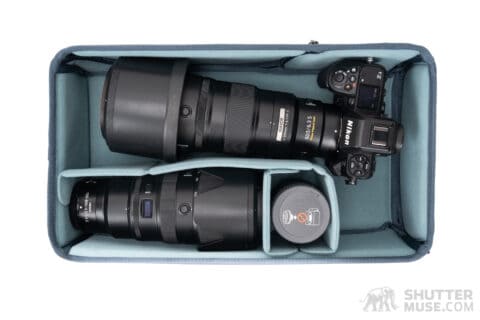
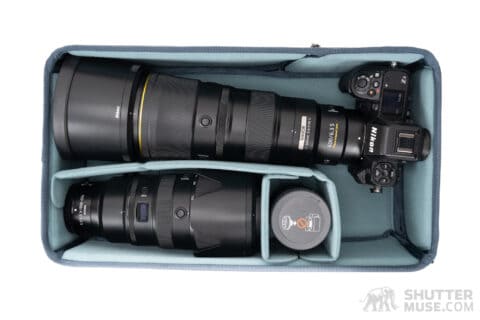
Having tested the various options, we can safely narrow things down to the Action X25, Action X30, Women’s Action X30, and the Action X40. The smallest Action X25, paired with the L25 RST Core Unit, allows you to leave the hood in the forward-facing shooting position. I think this combination of Action X25 and L25 RST Core Unit is the best of the bunch. It’s one of the smallest backpacks that still allows you to carry the mounted 600mm lens, and there’s still plenty of room for a second lens and teleconverters. You can also extract the lens from the bag’s roll-top, using the top zipper on the Core Unit–a feature unique to the RST Core Unit models.
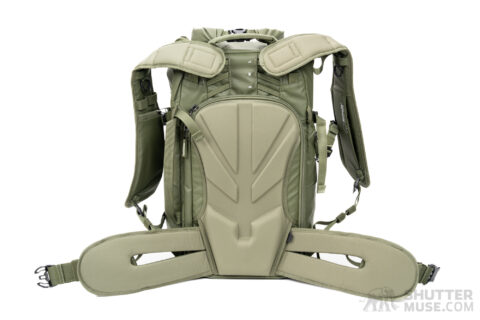
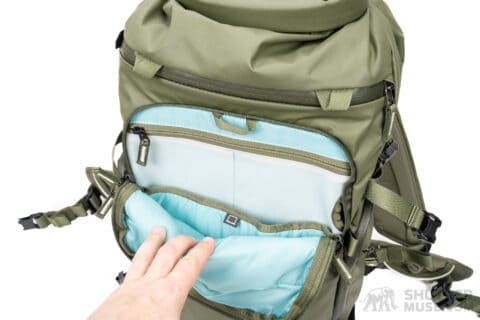
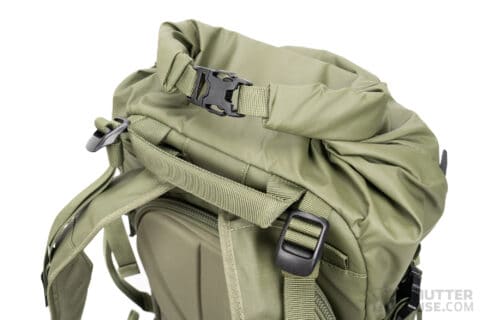
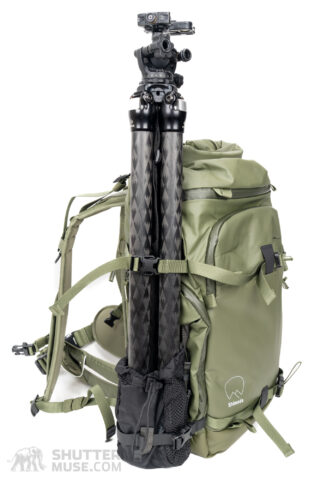
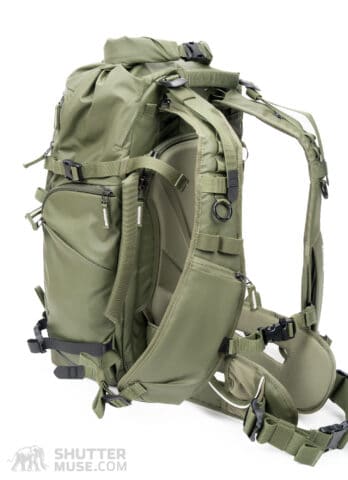
If you choose the Action X30, you’ll need to pair it with the Large Mirrorless Core Unit or the L30 RST Core Unit–the lens doesn’t fit in the Medium. With the Large Mirrorless Core Unit, you can fit the Z 600mm f/6.3 attached to a standard-sized camera body (Z8, Z7, Z6, etc.) with the lens hood in the reversed position. If you move up to the L30 RST Core Unit, you can leave the hood in the forward-facing shooting position.
If you move up to the larger, deeper Action X40, you can use gripped or pro-sized cameras like the Z9. For the X40, you need to choose the Large DSLR Core Unit or the XL40 RST Core Unit. The Large Core Unit is slightly longer than the Large Mirrorless Core Unit and lets you leave a smaller third-party lens hood in the forward shooting position attached to the lens. More on those lens hoods will be discussed later in the guide. The XL40 RST allows you to leave the original Nikon lens hood in the forward-facing position, and allows vertical extraction of the lens from the bag’s roll-top. The larger X50 and Action X70 HD models will generally not be needed by Z 600mm f/6.3 users unless you carry a ton of additional non-photographic gear.


Why choose a Shimoda Action X backpack over the other options on this list? I have included these camera bags mainly because of their second-to-none carrying comfort on long hikes. While I recommend the Gura Gear Kiboko backpacks as the ultimate travel-friendly safari solution, the Shimoda Action X V2 is the bag best suited to long hikes. The expandable roll-top design gives you much room for your non-photographic gear, and the Action X harness is fantastic. It even has a pocket for bear spray! It’s great for travel, too, featuring padded space for a laptop and tablet and carry-on friendly sizing.
Shimoda Designs has offered Shutter Muse readers a 10% discount on anything purchased through their online stores. US, Canadian, UK, French, or German residents should use the discount code ShutterMuse10 after clicking here to access the store. Australian readers should use the same code on the local Shimoda distributor’s site, Maxxum, instead.
- Action X25 v2 Kit – Shimoda / B&H / Amazon
- Action X30 v2 Shell – Shimoda / B&H / Amazon
- Action X30 v2 Kit – Shimoda / B&H / Amazon
- Action X40 v2 Shell – Shimoda / B&H / Amazon
- Action X40 v2 kit – Shimoda / B&H / Amazon
- Action X50 v2 Shell – Shimoda / B&H / Amazon
- Action X50 v2 Kit – Shimoda / B&H / Amazon
Think Tank FirstLight 35L+

The FirstLight Plus series from Think Tank Photo is designed for outdoor photography gear, including pro-sized camera bodies and super-telephoto lenses. A laptop pocket is also included. The bag is available in 35L+ and 46L+ sizes, with the plus symbol indicating an additional available volume from an expanding front pocket and a floating, removable top pocket. Unique among the recommended bags on this page, the FirstLight Plus backpacks include a padded collar to secure telephoto lenses in the bag, preventing any rattling while you walk.


The 46L+ model is a huge bag that is overkill for most people using the Z 600mm f/6.3. A much better fit is the FirstLight 35L+ model. This bag easily falls within the international carry-on limits for most airlines. However, it is still large enough to hold the Z 600mm f/6.3 with an attached camera body and the lens hood in the forward-facing “ready” position. For an alternative all-PF lens kit, the 35L+ will hold both the Nikon Z 800mm f/6.3 and the Z 600mm f/6.3. For more details about this bag and to see side-by-side photos of the 35L+ and 46L+ models, please read my Think Tank FirstLight review.

US Customers spending over $50 in Think Tank Photo’s online store can get a free gift at checkout after following one of the links to the store from this review–like this one. If you have any issues, please follow the instructions on this page.
Nikon Z 1.4x and 2x Teleconverters

“Should I buy a teleconverter?” is one of the most common questions I get from people when they have bought a new telephoto lens. The answer depends on the lens and the subjects you enjoy shooting. Adding the Nikon Z 1.4x teleconverter to the Z 600mm f/6.3 creates an 840mm f/9 lens, while adding the Z 2x teleconverter creates a 1200mm f/13 lens.
Having extensively tested the 1.4x and 2x teleconverter on this lens, I’m more than impressed. Slight sharpness and AF performance degradation are always expected, but astonishingly, the level of degradation–sharpness in particular–is more in line with what I have seen on the $15,000 Z 600mm f/4 TC VR S and beats the excellent with-TC performance I saw on the smaller Z 400mm f/4.5 VR S. It’s an incredible achievement, and one of the foundational reasons I believe this lens to be one of the all-time great telephoto primes.
In summary: In pure sharpness terms, the Nikon Z 600mm f/6.3 lens is one of the best-performing super-telephoto lenses there has ever been with teleconverters. Even wide-open, the results are incredible. Buying the Z 1.4x Teleconverter is a no-brainer if you shoot birds and smaller wildlife. Excellent sharpness is maintained with the 2x teleconverter, too. However, autofocus tracking performance takes a hit. For this reason, the Z 2x Teleconverter is better suited to those photographing perched birds, slower-moving wildlife, or large subjects like airplanes.





Replacement Lens Hood (Various Sizes)

Suppose you lose, damage, or destroy your original lens hood for the Nikon Z 600mm f/6.3 VR S; the Nikon HB-105A hood would be the direct replacement. Oddly, this hood appears identical to the Nikon HB-105 hood supplied with the Nikon Z 400mm f/4.5 VR S. I’m unsure why they needed to give the two slightly different part numbers. Having tested it, I can confirm that you can use the HB-105 hood instead of the HB-105A hood if you want, though I would not recommend it as it inexplicably costs more money.

A better alternative to using the original lens hood is to opt for a replacement hood made by Zemlin Photo. Zemlin lens hoods use a bayonet mounting system that does away with the fiddly push button on the side of the original Nikon lens hood. Zemlin hoods are also lighter, have a lower profile that takes up much less room in your camera bag, and come in various lengths.

Zemlin makes a hood that matches the original 3.54″ length of the HB-105A hood, but I prefer the shorter versions. The 2.56″ long version still offers plenty of protection from the sun, while the tiny 1.26″ version gives you an ultralight option that still protects the front element. The short 1.26″ version also prevents a build-up of warm air in the lens hood, which can cause blurry photos on a cold day. The real beauty of the Nikon Z 600mm f/6.3 lens is its small size, low weight, and packability. Using one of these smaller Zemlin lens hoods takes this concept even further. I have a Zemlin hood on all my super-telephoto lenses now.

A bonus of using a Zemlin hood is that your original lens hood remains unscratched, which adds to the eventual resell value. Unless wholly protected at all times, the lens hood tends to be the part of a lens that sees the most damage. With more expensive lenses like this 600mm prime, using a Zemlin hood will likely increase your resale value by more than the cost of the hood in the first place. That said, you can pry my 600mm f/6.3 out of my cold, dead hands! I’m never selling it!
Replacement Arca Foot

Despite most of its customers needing this feature, Nikon continues to deliver telephoto lenses with lens feet that are not Arca-Swiss compatible. Thankfully, the lens foot for the Nikon Z 600mm f/6.3 VR S does have toolless quick-release, and this has enabled a few third-party brands to manufacture excellent Arca-Swiss feet that can be swapped for the Nikon original.
My favorite replacement Arca foot for the Nikon Z 600mm f/6.3 is the Kirk LP-70. The foot features a beautifully machined Arca-Swiss dovetail with 1/4″-20 & 3/8″-16 Sockets on the base, safety stops, and a QD socket for use with QD (Quick Disconnect) camera straps.

The Kirk LP-70 replacement foot is conveniently compatible (and highly recommended) with the Nikon Z 400mm f/4.5 VR S, Nikon Z 100-400mm f/4.5-5.6 VR S, and Nikon Z 70-200mm f/2.8 VR S. If you have several of these lenses as I do, you probably don’t need to buy a replacement foto for every single one, as it’s unlikely you’ll ever pack so many telephotos for a day out. Instead, buy one or two and quickly slide them onto your weapon of choice for the day.

Another popular option is the Really Right Stuff LCF-21 lens foot. I’m sliding this into second place because it costs about $35 more than the Kirk LP-70. Still, I know many RRS fans love to keep some consistency in their support packages, and you can’t go wrong with an RRS lens foot. Like the Kirk’s foot, the RRS LCF-21 also features an integrated QD socket.
Replacement Lens Cap

The Nikon Z 600mm f/6.3 VR S features a 95mm filter thread, which means the official replacement lens cap is the Nikon LC-95B. If you lose the cap that came with your lens, the LC-95B lens cap will be a direct replacement. Still, there are better options.
In my extensive travels with 95mm-threaded lightweight telephoto Nikon Z-Mount lenses–Z 600mm f/6.3, Z 400mm f/4.5, and Z 180-600mm f/5.6-6.3–I have repeatedly arrived at my destination to find the original Nikon LC-95B lens cap pushed into the filter thread and towards the front lens element in an alarming way. I take good care of my gear when I travel, so these caps are being pushed towards the glass element with minimal force. The Nikon lens caps are poorly designed as an accessory for such an expensive lens.


If you fear arriving on location and finding the lens cap had rubbed up against the glass, as I do, there are a couple of great options. Firstly, you can opt for a neoprene LensCoat Hoodie. They feature a reinforced plastic insert to protect the front element and slip right over the lens and partially over the hood. The LensCoat Hoodies are available in a wide range of colors and sizes. If you use the OEM Nikon lens hood, you’ll want an XL LensCoat Hoodie. If you have opted for a Zemlin Photo replacement lens hood, you can comfortably step down to the Large LensCoat Hoodie. The Hoodies work well, but once removed, they are a bit bulkier for pocket storage than a traditional plastic lens cap.

The second option is to revisit our friends at Zemlin Photo. While Zemlin Photo started out making custom lens caps for larger super-telephoto lenses, its customers started asking for Zemlin lens caps in standard sizes. Shown in the photo above is a 95mm Zemlin lens cap. Once installed, this lens cap is far more secure than the OEM Nikon version and wide enough not to be forced toward the lens element. I’ll use the Zemlin cap in the field and reserve the LensCoat Hoodie for travel when paired with a TravelCoat. Unline Zemlin’s lens hoods, the lens caps are available from B&H Photo. These things are excellent and available for all super-telephoto lenses–see my review.
LensCoat Cover

I equip all my telephoto lenses with LensCoat Lens Cover. While I typically select the RealTree Max5 pattern from LensCoat’s extensive range of colors and patterns, I mainly wrap the lens for protection, not camouflage. This is different when I wrap Sony and Canon’s big white telephoto lenses that definitely need obfuscation in the field. However, Nikon is fairly sensible with their black lenses and minimal shiny bits.
The neoprene LensCoat covers offer good protection from bumps and scratches. They also offer a modest barrier against moisture, which can slightly prolong the time you’ll be able to spend in the rain before reaching for a rain cover. Protecting your lens from scratches will improve the resale value by more than the cover’s cost. I have used lenses for 6-8 years, only to remove the LensCoat to find them looking as good as new.
LensCoat Travel Coat

Travel Coats are another great LensCoat product that I use all the time. The Travel Coat is a neoprene cover that slips over the lens when the camera is not attached. I find these particularly useful while traveling, as they allow me to pack other items tightly around the lens in my backpack without fear of scratching the lens or those other items. With a lens in a Travel Coat, I routinely pack my teleconverters and camera bodies tight against the lens, allowing me to carry way more in my bag for the air travel stage of my trip.


The Best Camera Strap for the 600mm f/6.3


You already know that I highly recommend the Kirk Photo replacement foot for this lens. One reason is Kirk’s inclusion of a QD socket on the foot for use with QD camera straps. Creating a QD-compatible camera strap is as simple as buying a QD connector and attaching both ends to a good camera strap. I like the Peak Design Slide camera strap, and the new green or coyote colorways are good, natural-looking choices for wildlife photography.

With the QD system originating in the firearms industry, buying a Magpul rifle sling is another option. I have discussed using a Magpul sling for photography in a previous article. You can also use any BlackRapid sling strap if you pair it with Kirk’s D-shaped QD connector to ensure it hangs correctly from the single point attachment.
Cotton Carrier G3

The Cotton Carrier G3 harness is a great way to carry your Nikon Z 600mm f/6.3 when you want immediate access while hiking. After years of using the G3 harness with various cameras and lenses, I can say the Z 600mm f/6.3 hits the G3’s sweet spot when you attach the connection hub to the camera, not the lens foot. The lens is short enough that this setup works well and still leaves you plenty of visibility to your feet. The weight feels well-balanced, and I have no issues walking all day with the lens in this position. My record is 20+ miles around Richmond Park in London, photographing the stag rut with this lens on the G3.
An underrated benefit of this setup is that holding a larger lens to your eye is far less tiring when you don’t have a backpack on. Anyone who has held a long lens to their eye for a prolonged period while wearing a backpack will know that in this position, with your arms up to the camera, you feel a strain through your shoulders that can quickly induce some lens shake. I love my sense of freedom when using the little 600mm PF with this harness! Pro Tip: Pick up a Think Tank PressPass 10 fanny pack to carry spare batteries, memory cards, and binoculars. For more information, check out my in-depth review of the Cotton Carrier G3.
Cotton Carrier has offered Shutter Muse readers a 10% discount on anything purchased in their online store. Simply use the discount code SHUTTERMUSE after clicking here to access the store.
Rain Cover


While I trust the Nikon Z 600mm f/6.3 weather-sealing for short bursts of rain, I like to give it more protection in prolonged downpours. Think Tank’s Medium-sized Emergency Rain Cover is perfect for this lens. What I love about this camera rain cover is its small packed size. I can bury this in a camera bag pocket and forget it’s there until I need it. I also love the clever way the cover attaches to the camera’s hot shoe to keep it in place, and it works well with the camera mounted to the previously mentioned Cotton Carrier G3 harness.
Cable Lock

You may not have noticed, but the Nikon Z 600mm f/6.3 has a Kensington cable lock port hidden beneath a cover on the lens collar locking knob. These Kensington lock ports are common on larger lenses, but I was surprised to discover one on my 600mm f/6.3.
Kensington locks are often used to lock lenses to desks in media rooms at sporting events or to fixed objects on the sidelines. They can also lock your lens to something solid in a hotel room or a seatbelt tie-down point in a car. It won’t prevent a determined thief from stealing your lens if nobody is watching, but it’s a great deterrent to the more opportunistic ones for a comparatively minor cost.

Monopod and Monopod Head
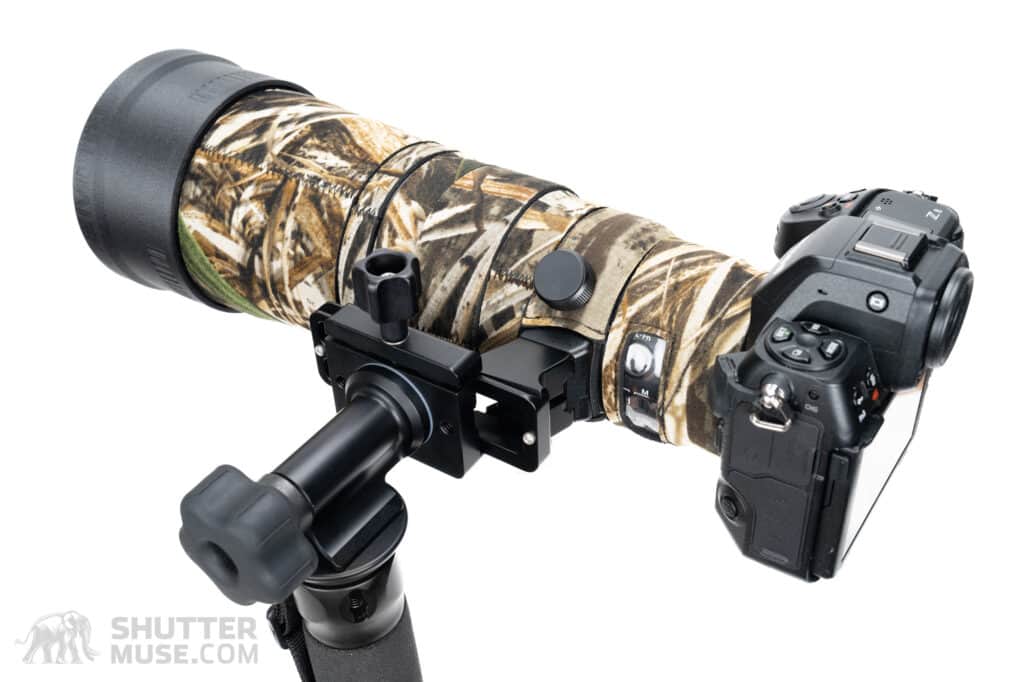
Tripod or monopod is the age-old question for wildlife photographers, and the lines get blurrier as the lenses get lighter. The Nikon Z 600mm f/6.3 lens is hand-holdable all day for most people. However, there are still times when additional support can allow you to use a longer shutter speed in low light, thus decreasing the necessary ISO for a correct exposure. For this reason, I wouldn’t entirely write off using a monopod with the Z 600mm f/6.3.
I do not doubt that the RRS MC-34 is the best monopod on the market. If your budget can stretch to it, get one, and you’ll have a stick-shaped companion for the rest of your life. If the Really Right Stuff monopod is beyond budget, the Robus RCM-439 monopod is 95% as good as the RRS for one-third of the price. Honestly, it’s a real bargain! I used the RRS MC-34, but a Robus will get the job done.
As for monopod heads, I’d go with the Wimberley MH-100 Monogimbal. Wimberley pioneered this unique side-mount style and has since been copied by brands with no imagination. Incredibly, some of the knock-offs are priced higher than the OG Wimberley. Accept no substitute in this area. I really enjoy using the Nikon Z 600mm f/6.3 PF with the Wimberley Monogimbal. Read my review of the Wimberley Monogimbal for more details.
Tripod and Ball Head (Flexshooter)
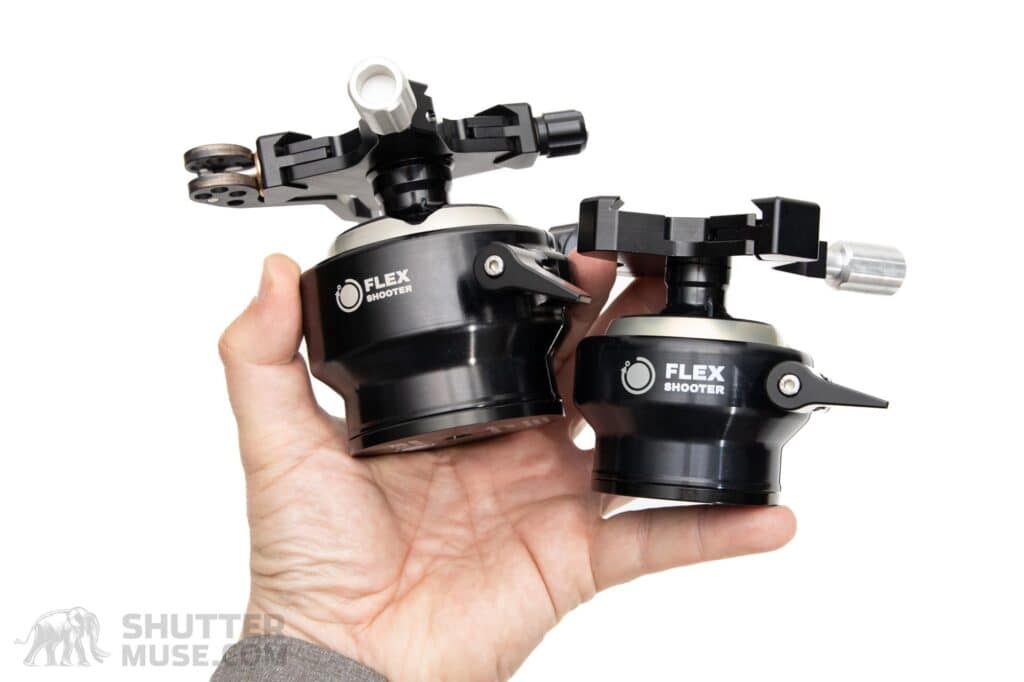
There aren’t many scenarios where I need a tripod for the Nikon Z 600mm f/6.3, but one example would be using the lens in a hide or at a birding setup where you’ll be in the same place for an extended period. In this case, I’d pick my RRS TFC-24L tripod. The “24L” version of RRS’ tripod is the best mid-sized tripod and has plenty of capacity for the Z 600mm f/6.3. The “TFC” variant is a lighter version with no option for an integrated leveling base. No leveling base is needed if you use a Flexshooter ball head.
If your budget can’t stretch to the RRS tripod, check out the Robus RC-5570 tripod. It’s half the price of the RRS option and represents fantastic value for money. Whichever tripod you choose, I’d pair it with Flexshooter Mini ball head.
My Flexshooter review goes into much more detail about this fascinating tripod head, but here’s the short version: The Flexshooter Mini has a built-in leveling ball and a spring-loaded counterbalanced inner ball that delivers a gimbal-like weightless feeling to your gear in a smaller and lighter package than any true gimbal on the market. You can use it as a regular ball head or lock the outer ball and limit its motion to pan and tilt, like a gimbal. The capacity of the Flexshooter Mini is perfect with the Nikon Z 600m f/6.3, and the unique double ball design makes it a great all-in-one tripod head for landscapes and wildlife.
Ground Pod

Ground pods allow you to get low-level wildlife images easily. Instead of fighting with a tripod, a ground pod easily slides along the beach, grass, or mud. I’d grab the Naturescapes Skimmer II or the LensCoat Ground Pod and pair it with the Flexshooter Mini. Check out my review of the Naturescapes Skimmer Ground Pod for more details.

Best Circular Polarizer


One of the significant benefits of the Nikon Z 600mm f/6.3 over its much larger Z 600mm f/4 TC VR S sibling is the possibility of using readily available 95mm screw-on filters instead of overpriced, hard-to-source rear drop-in filters. Unless you plan on shooting a lot of video with this lens, you will unlikely need an ND filter, but a circular polarizer (CPL filter) can be a great tool to mute reflected light and boost colors in wet environments. Whatever lens I’m using for wildlife photography, I always carry a CPL with me.
Choosing a high-quality filter is important when using it on a 600mm lens. You want to ensure the minimum color cast and sharpness degradation, and you need a perfectly flat filter. You may say “surely all glass filters are flat?”, but in my experience, it’s not the case with the cheap ones. I’ve even had issues with more expensive Nisi filters not being flat enough when used with a 600mm lens, resulting in selected areas of blurring. I recommend you choose a Breakthrough Photography X4 CPL. Although not cheap, it will cost you less than half the price of the Nikon C-PL460 drop-in CPL needed on the Z 600mm f/4, Z 400mm f/2.8, and Z 800mm f/6.3.


